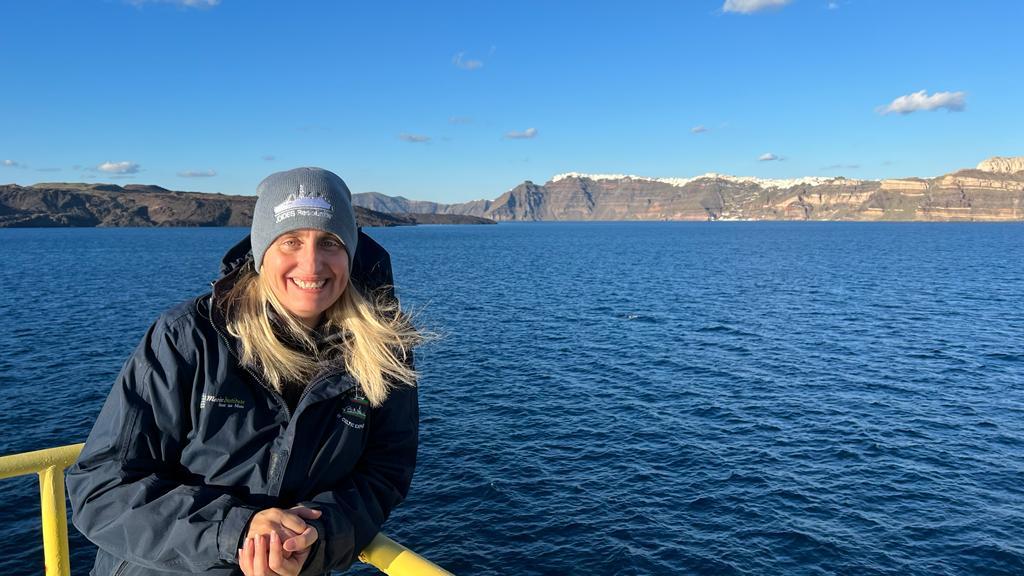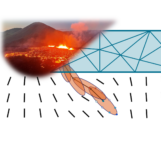
Santorini Island without a doubt is one of the top worldwide destinations, taking our breath away with its unparalleled beauty. However, from the geological perspective as well, this mystifying island can reveal hidden secrets of the past and pave the way for our future. In this week’s blog, Associate Professor Paraskevi Nomikou, the 2023 awardee of EGU’s Geoscience Days Grant from the National and Kapodistrian University of Athens will shed light on the well-kept secrets of the Kolumbo submarine volcano and will share more information about the SANTORY project, which is a highly-anticipated volcanic monitoring programme of the island.

Paraskevi (Evi) Nomikou onboard JOIDES Resolution during the IODP398 expedition (photo: Antony Morris). You can reach Evi via e-mail or on LinkedIn.
Submarine volcanoes are captivating geological features hidden beneath the depths of our planet’s oceans, often shrouded in mystery and intrigue. These underwater volcanoes are a unique and fascinating subset of the Earth’s volcanic activity, distinguished by their occurrence on the ocean floor rather than on the terrestrial landscape. While the study of terrestrial volcanoes has been ongoing for centuries, our understanding of submarine volcanoes has significantly expanded in recent decades, thanks to advancements in marine exploration and technology. Our research focuses on the Kolumbo submarine volcano, NE of Santorini in Greece, where we explore its formation, characteristics, the remarkable microbial life that thrives in its challenging environment, and the associated hazards that stem from subaquatic volcanic eruptions.
Christiana-Santorini-Kolumbo Volcanic Field
Located in the southern Aegean Sea in Greece, the Christiana-Santorini-Kolumbo volcanic field (CSK) is one of the most hazardous volcanic fields in the world and lies in an active continental rift zone (Nomikou et al., 2019). It has produced more than 100 explosive eruptions in the past 650 k.y., including at least four caldera-collapse events (Druitt et al., 1999). It is widely famous for the Minoan eruption of 3600 BC which may have contributed to the fall of the Minoan Civilisation. Northeast of Santorini lies the Kolumbo Volcanic Chain (KVC), which comprises more than 20 submarine volcanic cones, with the Kolumbo volcano being the most prominent feature of this chain (Nomikou et al., 2012).
Kolumbo crater morphology and structure
Kolumbo is a submerged active volcano and its most recent eruption in 1650 CE, generated a tsunami causing destruction in the islands of Santorini, Ios, and Sikinos, while the poisonous gas emitted from the eruption caused more than 70 casualties in Santorini (Fouque, 1879). Kolumbo’s edifice was created by at least five eruptive cycles, the earliest dating back more than 1M years (Preine et al., 2022). The most recent eruption, in 1650 CE, formed a cone consisting of up to ~260 m-thick stratified pumice deposits, which breached the sea surface before being destroyed by a violent explosive eruption that formed a 500 m-deep and 2,500 m-wide crater (Nomikou et al., 2012).
New high-resolution (2 m) bathymetry data (Nomikou et al., 2022) reveal the intricate morphological details of the cone formed by the 1650 eruption of Kolumbo. The 1650 cone consists of highly vesicular pumice, which was deposited as fallout from the eruption column, where many of the large pumice clasts floated at the sea surface before sinking. The cone had a volume of approximately 5 to 7 km³, which was deposited in a very short timeframe of only two weeks, based on eyewitness accounts (Klaver et al., 2016). The seafloor at the northern part of the Kolumbo crater hosts high (up to 220°C) and low (up to 70°C) temperature polymetallic chimneys and hydrothermal vents (Carey et al., 2013; Kilias et al., 2013;). The exterior of the chimneys and large areas of the seabed around Kolumbo were covered with reddish/orange microbial mats and streams of white/gray mats (Polymenakou et al., 2023).
Monitoring Kolumbo- SANTORY
Research on shallow submarine arc volcanoes is still in its infancy despite their potentially severe hazards. When Kolumbo erupted in 1650, it caused significant damage to the nearby islands of Santorini, Ios, and Sikinos. At least 70 people who were either at sea or along the NE coastline of Santorini died of asphyxiation due to acidic gases released by the intense eruption and a large tsunami caused widespread damage on Santorini and on other islands within a 150 km radius. Kolumbo is currently the most active submarine volcano of the CSK and is considered the most dangerous submarine volcano in the Mediterranean Sea, partly because it is prone to explosive activity (Nomikou et al., 2022). A recent study (Karsten et al., 2023) shows that a future explosive event of Kolumbo poses a significant hazard to the northern and west coasts of Santorini, therefore we believe that it is imperative to monitor Kolumbo’s activity to minimize the risks and avoid human casualties and the destruction of the local economy and infrastructure in case of an eruptive event.

Figure 3: Deployment of SANTORY automated seafloor system for geochemical multi-parametric monitoring (photo: Paraskevi Nomikou).
At present, we are monitoring Kolumbo with a deployed underwater observatory. SANTORY (SANTORini’s seafloor volcanic observatorY) is a research project (www.santory.gr) with partners from international institutions (INGV-Palermo, GEOMAR) and universities (NKUA, HCMR-IMBBC, NTUA, ENS-PSL, UNIWA) funded by H.F.R.I. (Hellenic Foundation for Research and Innovation). The project aims to comprehend the links between deep-seated geological processes that have associated risks and their expression in hydrothermal activity. Our international research team monitors Kolumbo by developing and integrating state-of-the-art technology for in situ monitoring along with discrete sampling and measurements. So far, we conducted two oceanographic expeditions funded by the municipality of Thera to a) deploy and maintain the seafloor observatory, which is a new generation automated geochemical recording system that collects data of acoustics, dissolved CO2, H2S, O2, T °C, pressure, EC, pH, and turbidity (Fig. 3), b) conduct various measurements on Kolumbo’s crater with multiple innovative sensors (T-sensors, Inclinometers, Pressure gauges) (Fig. 4), c) continuously record the active hydro-thermal vent field with Stand-alone optical cameras, multispectra and the “THEIA” stereo camera and d) make for the first time, real-time measurements for radioactivity using gSniffer and γ-radiation imager “SUGI”.

Figure 4a: Deployment of SANTORY Pressure Gauge-(left) (photo: SANTORY). Figure 4b: Deployment of SANTORY Inclinometer-(right) (photo: SANTORY).
Volcanic monitoring plays a pivotal role in advancing our understanding of how underwater volcanoes form and evolve. By continuously observing volcanic activity, scientists gain valuable insights into the complex interplay of forces beneath our planet’s surface and in turn can help government agencies and the local community to plan and prepare for an imminent crisis. Gaining such knowledge is crucial not only for shedding light to uncover the evolutionary history of the volcano but also for assessing volcanic hazards and protecting communities at risk. By studying volcanic systems over time, we can detect patterns and anomalies, enhancing our ability to predict eruptions and mitigate their impact.
SANTORY Project (Video created by GAPfilmingteam).
References Carey et al. (2013). CO2 Degassing From Hydrothermal Vents at Kolumbo Submarine Volcano, Greece, and the Accumulation of Acidic Crater Water. Geology 41, 1035–1038. Druitt et al. (1999). Santorini Volcano Vol. 19165 (London, UK: Geological Society of London, Memoirs). Fouqué, F. (1879). Santorin et ses éruptions. G. Masson. Karsten et al., (2023-in revision): Set up to fail –cascading events during the 1650 tsunamigenic eruption of Kolumbo volcano. Nature Communications. Kilias et al. (2013). New Insights Into Hydrothermal Vent Processes in the Unique Shallowsubmarine Arc-Volcano, Kolumbo (Santorini), Greece. Sci. Rep. 3, 2421. Klaver et al., (2016). A distinct source and differentiation history for Kolumbo submarine volcano, Santorini volcanic field, Aegean arc. Geochemistry, Geophysics, Geosystems, 17(8), 3254-3273. Nomikou et al., (2012). Submarine Volcanoes of the Kolumbo Volcanic Zone NE of Santorini Caldera Greece. Glob. Planet. Change 9, 135–151. Nomikou P., Hübscher C., Carey S. (2019). The Christiana–Santorini–Kolumbo Volcanic Field. Elements; 15 (3), 171–176. Nomikou et al., (2022). SANTORY: SANTORini’s Seafloor Volcanic ObservatorY. Frontiers in Marine Science, 9. Polymenakou et al., (2023). Taxonomic diversity of microbial communities in sub-seafloor hydrothermal sediments of the active Santorini-Kolumbo volcanic field. Frontiers in Microbiology, 14. Preine et al., (2022). Spatio-temporal evolution of the Christiana-Santorini-Kolumbo volcanic field, Aegean Sea. Geology, 50(1), 96-100.






